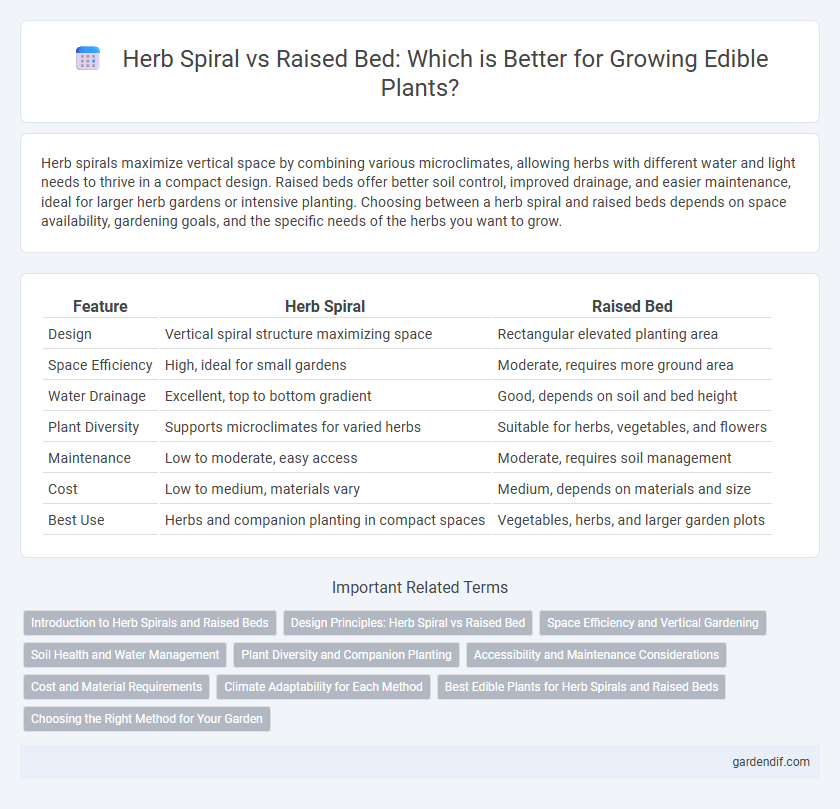
Herb Spiral vs Raised Bed Illustration
Herb spirals maximize vertical space by combining various microclimates, allowing herbs with different water and light needs to thrive in a compact design. Raised beds offer better soil control, improved drainage, and easier maintenance, ideal for larger herb gardens or intensive planting. Choosing between a herb spiral and raised beds depends on space availability, gardening goals, and the specific needs of the herbs you want to grow.
Table of Comparison
| Feature | Herb Spiral | Raised Bed |
|---|---|---|
| Design | Vertical spiral structure maximizing space | Rectangular elevated planting area |
| Space Efficiency | High, ideal for small gardens | Moderate, requires more ground area |
| Water Drainage | Excellent, top to bottom gradient | Good, depends on soil and bed height |
| Plant Diversity | Supports microclimates for varied herbs | Suitable for herbs, vegetables, and flowers |
| Maintenance | Low to moderate, easy access | Moderate, requires soil management |
| Cost | Low to medium, materials vary | Medium, depends on materials and size |
| Best Use | Herbs and companion planting in compact spaces | Vegetables, herbs, and larger garden plots |
Introduction to Herb Spirals and Raised Beds
Herb spirals maximize vertical space by arranging herbs in a spiral formation, creating microclimates that support diverse plant growth. Raised beds enhance soil quality and drainage through elevated planting areas, improving root health and yield. Both methods optimize garden space, but herb spirals prioritize vertical layering while raised beds focus on horizontal expansion.
Design Principles: Herb Spiral vs Raised Bed
Herb spirals maximize vertical space by creating a compact, tiered structure that promotes microclimates for diverse herb growth, while raised beds emphasize horizontal, accessible soil depth for root development and ease of maintenance. The spiral design integrates water retention and sunlight exposure gradients, optimizing resource efficiency and plant health, whereas raised beds prioritize soil quality control and ergonomic gardening practices. Both methods support sustainable edible garden principles but differ in spatial arrangement, planting density, and environmental adaptability.
Space Efficiency and Vertical Gardening
A herb spiral maximizes space efficiency by utilizing vertical gardening techniques, allowing multiple herbs to grow in a compact, tiered structure that conserves ground area. Raised beds provide a flat, accessible growing surface but require more horizontal space and lack the vertical dimension for maximizing plant density. Incorporating vertical elements like herb spirals enhances yield per square foot compared to the traditional horizontal layout of raised beds.
Soil Health and Water Management
Herb spirals promote superior soil health by creating diverse microclimates that enhance beneficial microbial activity and nutrient cycling, while raised beds offer controlled soil conditions that reduce compaction and improve root aeration. Water management in herb spirals benefits from gravity-fed irrigation cascading down the spiral, minimizing runoff and maximizing moisture retention. Raised beds facilitate efficient water distribution and drainage, preventing waterlogging and ensuring consistent hydration for optimal plant growth.
Plant Diversity and Companion Planting
Herb spirals maximize plant diversity by stacking microclimates vertically, allowing herbs with varying water and sunlight needs to thrive together, which enhances companion planting benefits. Raised beds offer spacious, customizable soil environments that support a broader range of plant species and facilitate crop rotation, improving biodiversity and pest control. Both methods promote plant health and yield, but herb spirals optimize spatial efficiency while raised beds provide greater flexibility for diverse companion planting strategies.
Accessibility and Maintenance Considerations
Herb spirals offer vertical growing space that maximizes accessibility by allowing gardeners to reach multiple herb layers from a central point, reducing bending and stretching. Raised beds provide easier soil management and improved drainage, making maintenance tasks like weeding and harvesting more straightforward, especially for those with mobility challenges. Both designs enhance accessibility, but raised beds typically require less ongoing upkeep due to their structured layout and soil containment.
Cost and Material Requirements
Herb spirals generally require fewer materials, utilizing stones or bricks to create vertical planting space, which reduces the need for large amounts of soil compared to raised beds. Raised beds often demand more wood, metal, or composite materials to build sturdy frames, increasing initial costs significantly. Cost efficiency in herb spirals stems from their compact design and natural elements, while raised beds involve higher investment but offer easier soil management and accessibility.
Climate Adaptability for Each Method
Herb spirals excel in microclimate creation by utilizing vertical space to generate temperature gradients, making them highly adaptable to temperate and Mediterranean climates. Raised beds improve soil drainage and warming in cooler or wetter regions, enhancing plant growth by optimizing soil conditions. Both methods allow for strategic plant placement based on sunlight and moisture needs, but raised beds offer more flexibility in colder climates due to easier soil amendments and insulation options.
Best Edible Plants for Herb Spirals and Raised Beds
Herb spirals thrive with Mediterranean herbs such as rosemary, thyme, oregano, and basil, benefiting from the vertical microclimates that enhance growth and flavor concentration. Raised beds support a wider variety of edible plants like tomatoes, lettuce, carrots, and beans due to improved soil drainage and accessibility for root expansion. Selecting the appropriate structure depends on plant growth habits and space efficiency, optimizing yields for specific edible crops.
Choosing the Right Method for Your Garden
Selecting between a herb spiral and a raised bed depends on garden space, plant variety, and maintenance preferences. Herb spirals maximize vertical space and create microclimates ideal for diverse herbs, while raised beds offer better soil control and accessibility for larger vegetable or flower gardens. Understanding soil drainage, sunlight exposure, and plant requirements ensures the chosen method supports optimal growth and harvest.
Herb Spiral vs Raised Bed Infographic

 gardendif.com
gardendif.com